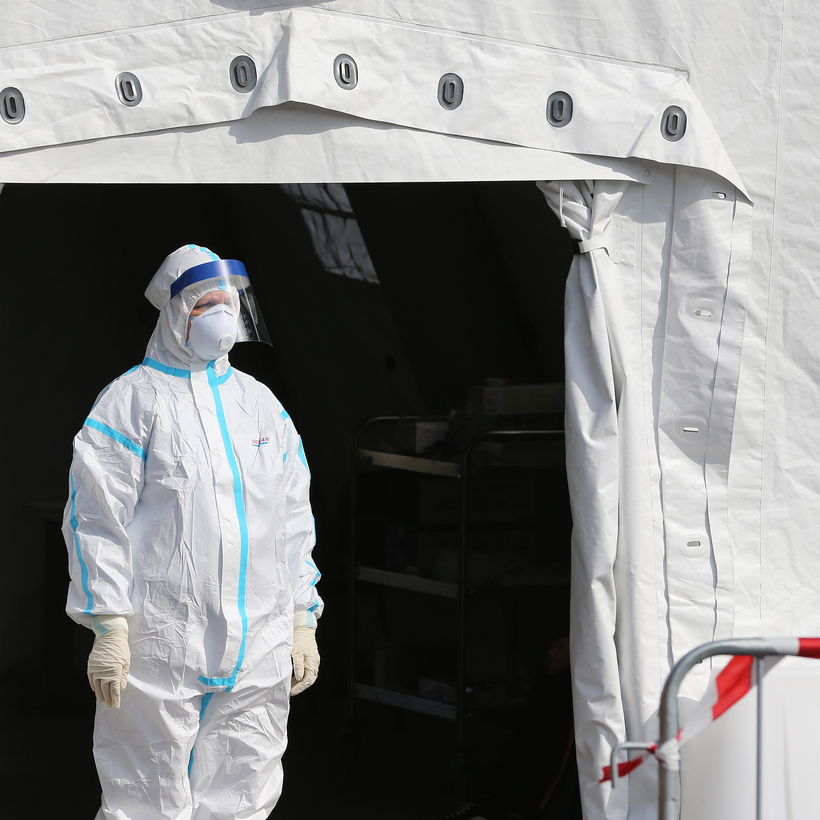“He tested positive.”
“He” is an elderly African-American man, prone on an I.C.U. bed behind the sliding glass doors. There is the usual ugly pink rubber tube in his mouth, attached to the breathing machine. He has the intravenous contraption, and monitor electrodes on his chest. His heart is beating fast. Nurse Mulligan is injecting saline into his IV. At least I think it’s Nurse Mulligan. I can’t quite tell, because she’s encased in yellow with a yellow paper hat, a blue N95 mask, and a second mask with a visor.
Outside the room I ask, “What’s his story?”
“His daughter had been in Italy,” I am told. “She flew back to her dad’s house in upstate New York. She was coughing on the plane. The next day she had a fever and felt terrible, and she called the state’s Department of Health herself. Two men in hazmat suits met her in the parking lot of the hospital. They took nose swabs from her and her father and told them to quarantine themselves at home. It took 48 hours for the tests to come back, and both were infected with the coronavirus. By the time she got the results, she was already feeling better, and her father was feeling as healthy as ever. But then, the next day, he suddenly came down with a high fever.”
Coronaviruses are so called because their outer surface resembles a crown. They are found in bats all over the world. But the bats don’t sicken. They are a reservoir. And they’re not the only one. Rodents—the largest order of mammalian species in the world—are another. What species do they infect? A large number of them, including dogs, cats, camels, and humans. Single-stranded RNA viruses, they evolve rapidly and adapt effortlessly to living in new hosts. (As opposed to DNA viruses, such as herpes, which rarely jump species.) The first ones appeared on earth more than 10,000 years ago.
I am an infectious-disease doctor who trained at Albert Einstein College of Medicine and worked for many years at N.Y.U. I moved upstate to retire, or at least semi-retire. But you can’t let a global pandemic go by without at least showing up. So here I am.
I gown up.
My mind has conjured an image of the well-known engraving of a plague doctor at the time of the Great Plague. He is Dr. Beak, and his long mask is filled with cloves and garlic. He’s wearing a long black gown, a hat, and kid gloves, and is carrying a stick for some purpose.

What does the patient think when they see Darth Vader—the new Dr. Beak—at the foot of their bed?
Quick! Say something reassuring!
“Hello, how are you? You’re looking better.”
It comes out as a growl through the mask.
The patient looks his 80 years. He is pale and sweaty, but alert. He’s got a lowish blood pressure that’s being maintained by intravenous medicines. Not much coming out of the endotracheal tube. Passing fair volumes of urine. A fast, irregular heartbeat—and a history of underlying heart disease. I hear crackles and wheezes through the stethoscope. No bowel sounds. He’s pretty sick. I am pessimistic. If I hadn’t known about the coronavirus, I would have called this influenza. In an older and therefore immunocompromised man.
What does the patient think when they see Darth Vader—the new Dr. Beak—at the foot of their bed?
I look up and wave at my two colleagues standing outside the room. Because, at this point, I am in the room looking out. This has been the physician’s place since before Hippocrates: through plague, pandemic, infestation, scourge, and pestilence, we have been in the room looking out. Many lost their lives. As I contemplate this, I feel, for the first time, a little flicker of anxiety.
“No,” I tell myself. “Keep calm and carry on.”
The latest data from South Korea—where they are testing a broad spectrum of people—shows a mortality of 1.3 percent, which is only slightly higher than that of influenza. Remember influenza? The cause of 34,000 American deaths last year without anyone noticing? Were you worried about that?
Does a physician have a duty to treat? I have no doubt about that. But what if his or her life is also seriously endangered? What then? I do not consider this such a situation.
But what if it were? Would there still be a duty to treat?
Just over a hundred years ago, a global pandemic of influenza killed an estimated 50 million people. (That’s a conservative estimate.) Six hundred American doctors lost their lives. Should they have died, too?
But this is not the Spanish flu. I repeat: this is not the Spanish flu.
The overall mortality will likely be much lower, for starters. But there’s another reason this is not the Spanish flu: Back then, we barely knew what viruses were. We didn’t have oxygen on demand, intravenous fluids, antibiotics for secondary bacterial infection, ventilators …
I take off my visor and put it on a flat surface. I take off my gloves, wash my hands, put on a new pair of gloves. I clean the visor with spirits, put the visor in a brown paper bag with my name on it. I take off the gloves, wash my hands, put on another new pair of gloves. I put my N95 face mask in a brown paper bag with my name on it and leave it with the other bag outside the room.
I look up at the four health-care providers: a nurse, a respiratory therapist, an infection-control administrator, and an intensivist. We discuss treatment. We are in the process of getting into a prospective trial of Remdesivir, the drug that was used to fight Ebola. For now, we use an anti-viral called Kaletra and hydroxychloroquine, an anti-malarial. It’s all empirical. That is to say, there is no objective evidence that any of it works. But if, according to the medical grapevine, it could have some benefit and its side-effect profile is low, why not treat the patient?
So far, we have had four patients in the ICU on ventilators and another dozen who may or may not have the infection in regular hospital beds. What’s next? Many are the predictions, but the reality will arrive one day at a time.
I look up. “Right,” I say. “Who’s free for lunch?”
John Froude is the author of the forthcoming book Ten Plagues


